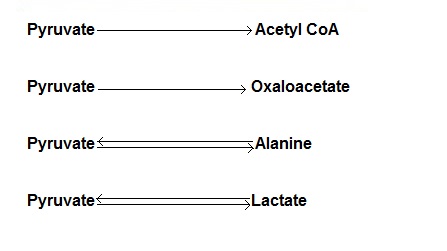 Being extolled as an ergogenic aid, pyruvate provides energy to the cells via Krebs cycle in the presence of oxygen. It is an intermediate metabolite in glucose – alanine cycle and unites many important metabolic reactions in the body.
Being extolled as an ergogenic aid, pyruvate provides energy to the cells via Krebs cycle in the presence of oxygen. It is an intermediate metabolite in glucose – alanine cycle and unites many important metabolic reactions in the body.

Natural Sources:
Pyruvate is normally produced in the body. However, it can also be obtained from foods, ranging from 100 mg to 2000 mg daily. Foods high in pyruvate include fruits especially red apple (500 mg each), vegetables, most cheeses, dark beer, and red wine.
Athletic Benefits of Pyruvate:
Pyruvate supplementation enhances glucose transport into active muscles. This process  is called “glucose extraction”, which provides an energy source to sustain high-intensity aerobic exercise while sparing glycogen storages in the muscles.
is called “glucose extraction”, which provides an energy source to sustain high-intensity aerobic exercise while sparing glycogen storages in the muscles.
As the muscles exercise, the amino acids break down into nitrogen, which has to be removed. Alanine carries nitrogen back to the liver wherein it can be converted into urea and eventually excreted via urine. Pyruvate elevates alanine level in the muscles.
Pyruvate exhibits better results when combined with dihydroxyacetone (DHA) and creatine monohydrate.
Potential benefits of pyruvate in athletes are:
- Improves athletic endurance.
- Delays exhaustion time and exercise – induced fatigue.
- Spares glycogen storages.
- Changes body composition.
Non – Athletic Benefits of Pyruvate:
Pyruvate may be beneficial in the following conditions:
- As a mild antioxidant.
- Aging skin. Applying a 50% pyruvate may smooth skin, decrease fine wrinkles, and decrease dark spots associated with aging due to sun exposure.
- Weight loss.
- Obesity.
- Cataracts.
- Cancers.
Dosage and Side Effects:
The usual dosage of pyruvate in athletes is 5 – 10 grams daily. As a weight loss aid, the dosage would be 10 – 30 grams a day. Some pyruvate consumers may experience stomach upset, bloating, diarrhea, and skin reaction if applied as pyruvic acid facial peel.

